
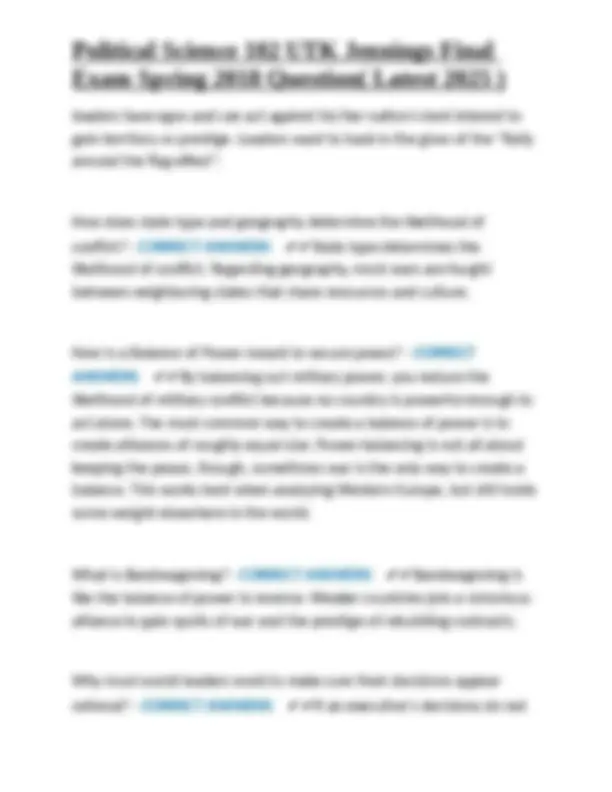
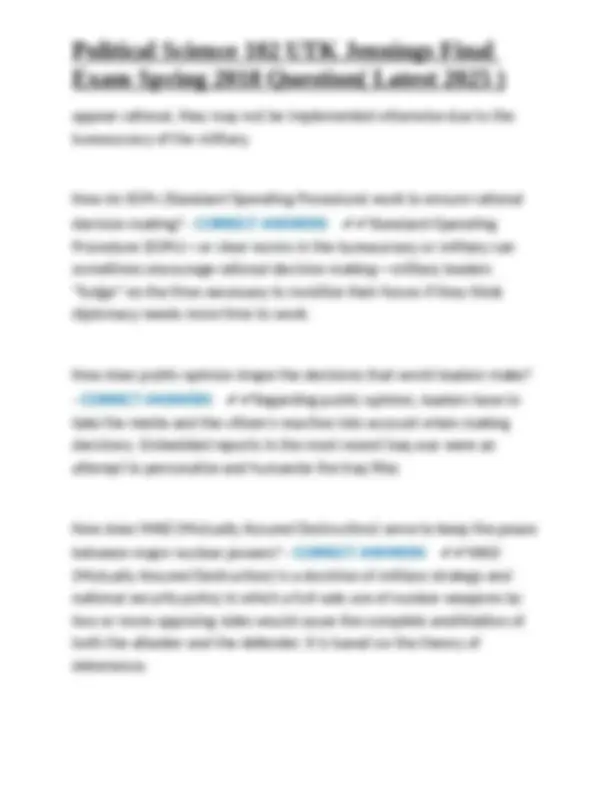
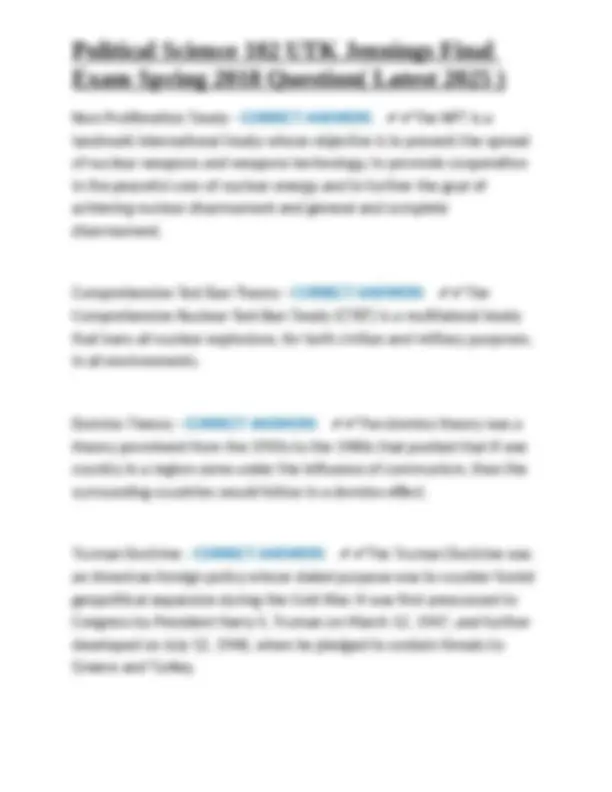
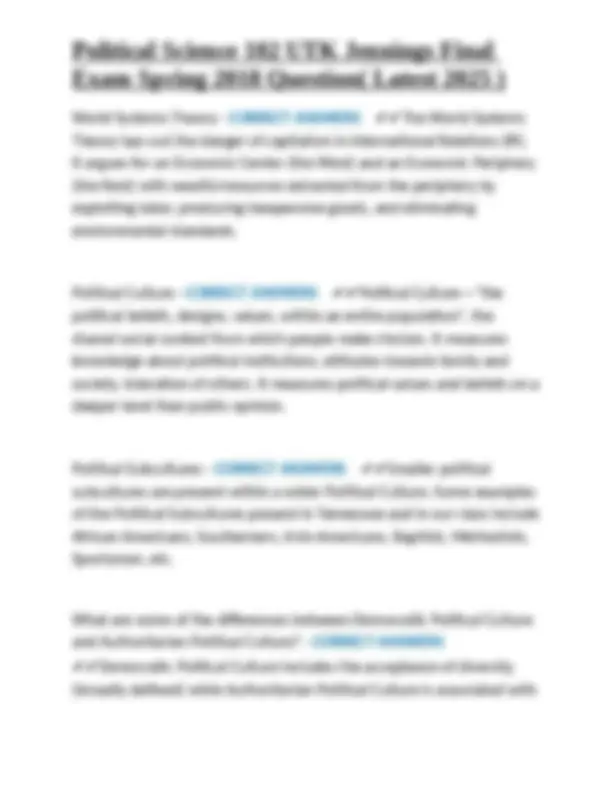
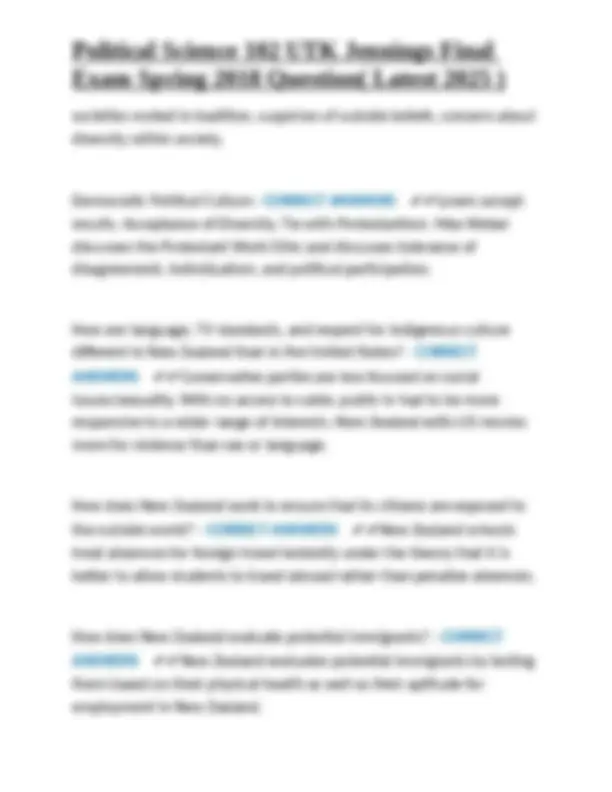
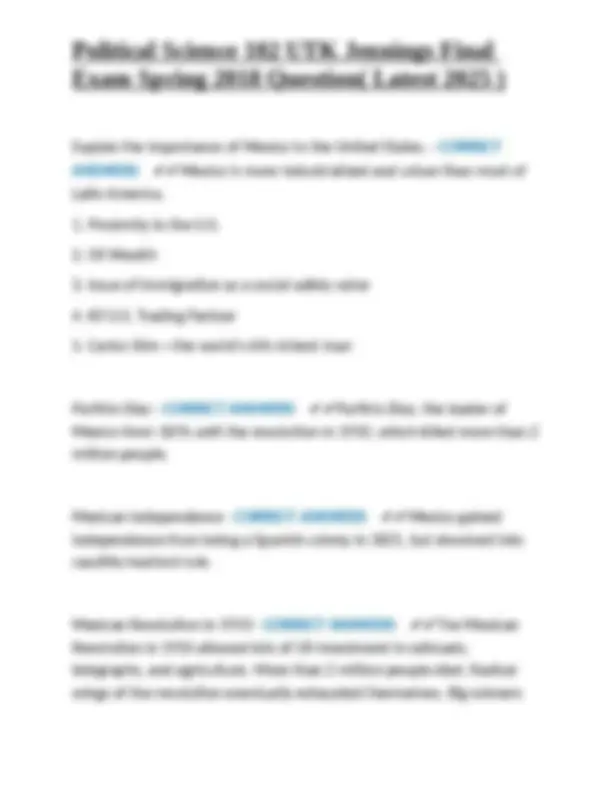
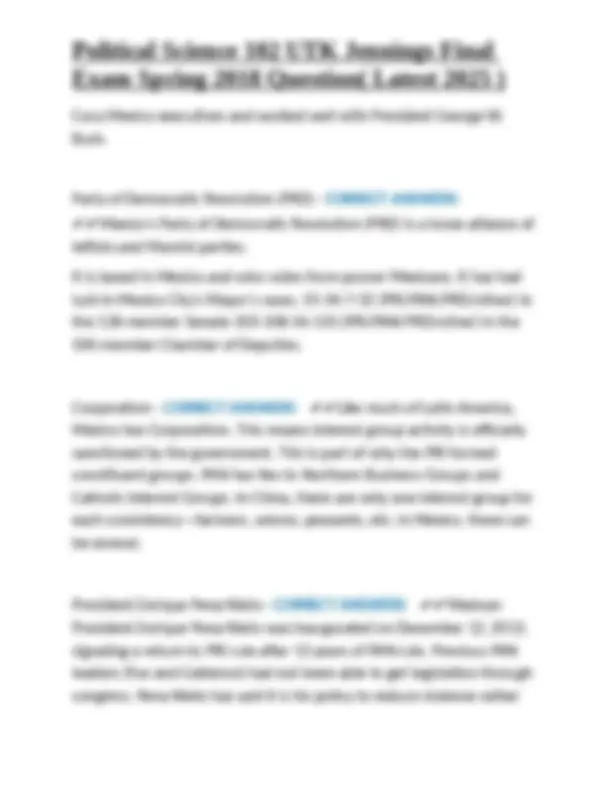
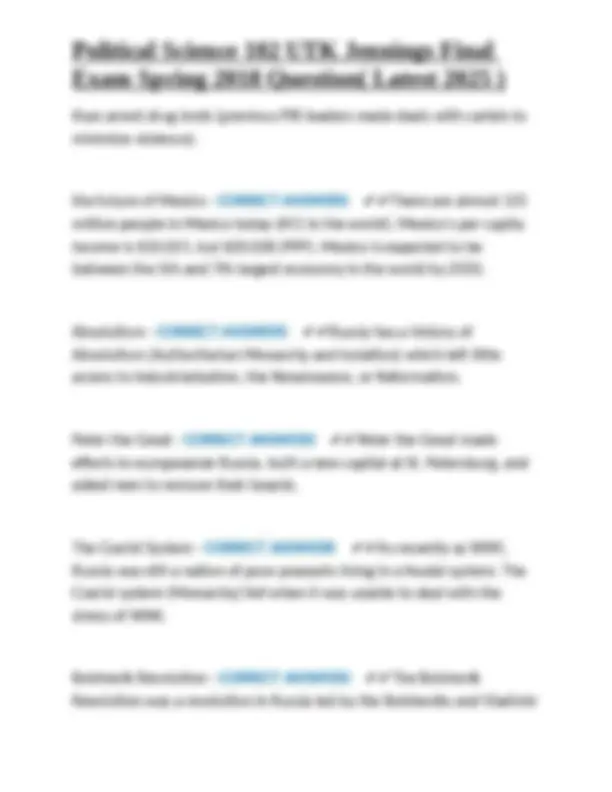
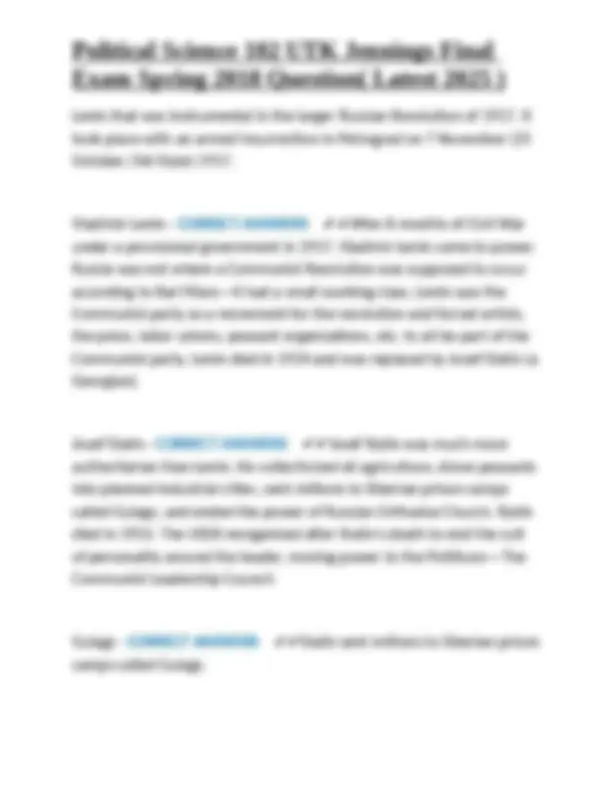
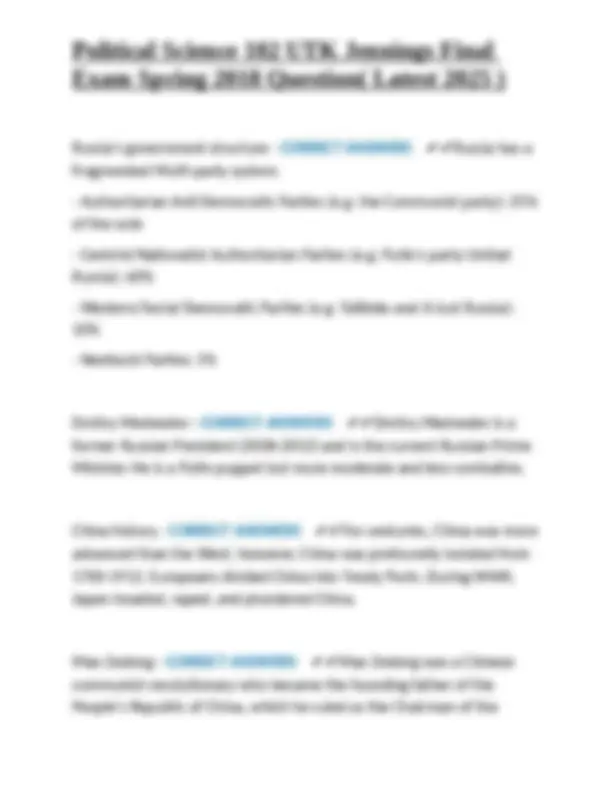
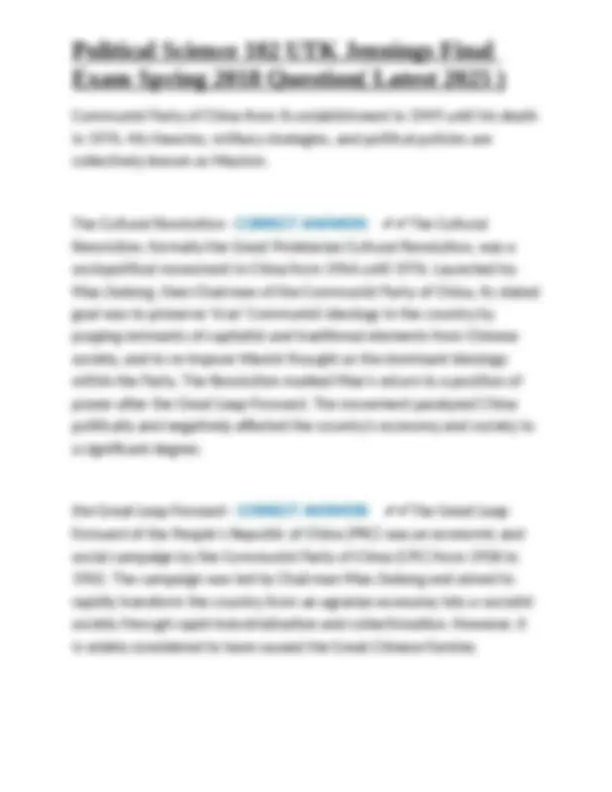
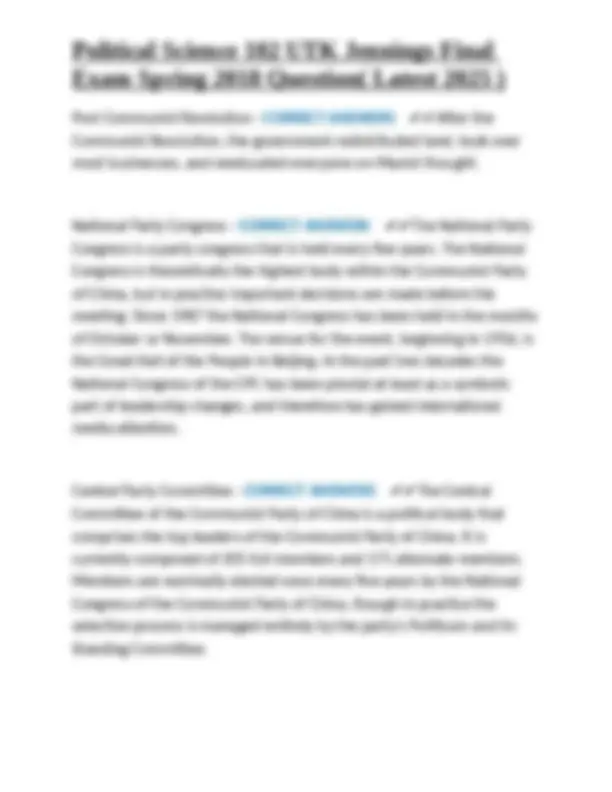
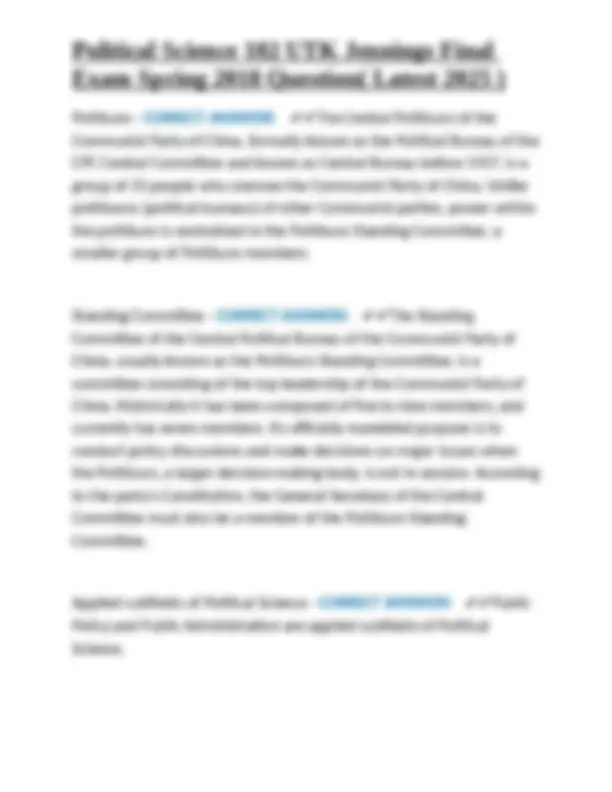
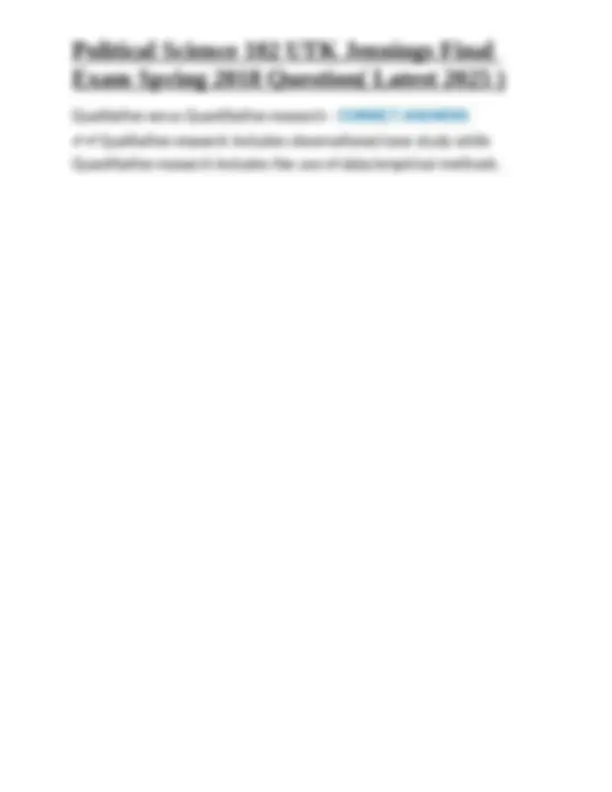


Study with the several resources on Docsity

Earn points by helping other students or get them with a premium plan


Prepare for your exams
Study with the several resources on Docsity

Earn points to download
Earn points by helping other students or get them with a premium plan
Community
Ask the community for help and clear up your study doubts
Discover the best universities in your country according to Docsity users
Free resources
Download our free guides on studying techniques, anxiety management strategies, and thesis advice from Docsity tutors
Political Science 102 UTK Jennings Final Exam Spring 2018 Question( Latest 2025 )
Typology: Exams
1 / 22

This page cannot be seen from the preview
Don't miss anything!















What are the defining differences between Comparative and IR? - CORRECT ANSWERS ✔✔Comparative Politics takes place in a settled order. IR has much less order and a lot more fluidity. The actions of some are very unpredictable. What are the key subfields of International Relations? - CORRECT ANSWERS ✔✔The subfields of international relations are International Political Economy (Globalization), Foreign Policy/Diplomacy, Security Studies (War and Peace), and IR Theory. What event led to creation of IR as a field of study? - CORRECT ANSWERS ✔✔World War I led to creation of IR as a field because it affected four continents. Before that, conflict and relations was mostly studied by historians. What do Idealists assume will lead to the prevention of war? - CORRECT ANSWERS ✔✔Idealists argue war can be prevented if states follow international law and back international organizations. Which U.S. President was key to the creation of Idealism as an IR ideology? - CORRECT ANSWERS ✔✔Woodrow Wilson felt war would be less likely if states negotiated in an organized forum.
How do Idealists argue conflict can be prevented? - CORRECT ANSWERS ✔✔Idealists argue that war can be prevented through educating people on the futility and cost of war and that war is the result of blindly followed and ill-conceived ideologies. Idealists also argue that war is the result of accidents, insanity (non-rationality), or miscalculation/misperception. Idealists/liberal institutionalist/regime theorists observe that there is cooperation despite anarchy. Cooperation in trade, human rights, and collective security are cited, among other issues. What are the guiding principles of Realism? - CORRECT ANSWERS ✔✔Realism emphasizes the role of the nation-state and makes a broad assumption that all nation-states are motivated by national interests, or at best, national interests disguised as moral concerns. According to realists, what should states do to guarantee their security?
appear rational, they may not be implemented otherwise due to the bureaucracy of the military. How do SOPs (Standard Operating Procedure) work to ensure rational decision making? - CORRECT ANSWERS ✔✔Standard-Operating Procedure (SOPs)—or clear norms in the bureaucracy or military can sometimes encourage rational decision making—military leaders "fudge" on the time necessary to mobilize their forces if they think diplomacy needs more time to work. How does public opinion shape the decisions that world leaders make?
Non-Proliferation Treaty - CORRECT ANSWERS ✔✔The NPT is a landmark international treaty whose objective is to prevent the spread of nuclear weapons and weapons technology, to promote cooperation in the peaceful uses of nuclear energy and to further the goal of achieving nuclear disarmament and general and complete disarmament. Comprehensive Test Ban Theory - CORRECT ANSWERS ✔✔The Comprehensive Nuclear-Test-Ban Treaty (CTBT) is a multilateral treaty that bans all nuclear explosions, for both civilian and military purposes, in all environments. Domino Theory - CORRECT ANSWERS ✔✔The domino theory was a theory prominent from the 1950s to the 1980s that posited that if one country in a region came under the influence of communism, then the surrounding countries would follow in a domino effect. Truman Doctrine - CORRECT ANSWERS ✔✔The Truman Doctrine was an American foreign policy whose stated purpose was to counter Soviet geopolitical expansion during the Cold War. It was first announced to Congress by President Harry S. Truman on March 12, 1947, and further developed on July 12, 1948, when he pledged to contain threats to Greece and Turkey.
International Court of Justice (ICJ) - CORRECT ANSWERS ✔✔The International Court of Justice (abbreviated ICJ; commonly referred to as the World Court) is the principal judicial organ of the United Nations (UN). It settles legal disputes between member states and gives advisory opinions to authorized UN organs and specialized agencies. It comprises a panel of 15 judges elected by the General Assembly and Security Council for nine-year terms. It is seated in the Peace Palace in The Hague, Netherlands. Foreign Policy Analysis - CORRECT ANSWERS ✔✔Foreign Policy Analysis looks at how important leaders make decisions within existing political institutions. It utilizes profilers and psychological analysis of leaders to be effective. Hegemonic Stability Theory - CORRECT ANSWERS ✔✔Hegemonic Stability Theory looks at the role that hegemony have in stabilizing the international system. Hegemons usually created and enforced rules on investment and trade. The US helped to create the GATT, International Monetary Fund, and World Bank at Bretton Woods, New Hampshire in July 1944. Things like car safety standards, the pricing of oil in dollars, and even accounting standards are dictated because the US established the rules.
World Systems Theory - CORRECT ANSWERS ✔✔The World Systems Theory lays out the danger of capitalism in International Relations (IR). It argues for an Economic Center (the West) and an Economic Periphery (the Rest) with wealth/resources extracted from the periphery by exploiting labor, producing inexpensive goods, and eliminating environmental standards. Political Culture - CORRECT ANSWERS ✔✔Political Culture—"the political beliefs, designs, values, within an entire population", the shared social context from which people make choices. It measures knowledge about political institutions, attitudes towards family and society, toleration of others. It measures political values and beliefs on a deeper level than public opinion. Political Subcultures - CORRECT ANSWERS ✔✔Smaller political subcultures are present within a wider Political Culture. Some examples of the Political Subcultures present in Tennessee and in our class include African Americans, Southerners, Irish-Americans, Baptists, Methodists, Sportsmen, etc. What are some of the differences between Democratic Political Culture and Authoritarian Political Culture? - CORRECT ANSWERS ✔✔Democratic Political Culture includes the acceptance of diversity (broadly defined) while Authoritarian Political Culture is associated with
Explain the importance of Mexico to the United States. - CORRECT ANSWERS ✔✔Mexico is more industrialized and urban than most of Latin America.
were the urban middle-class moderates, who then formed the Party of Industrial Revolution (PRI) in 1920. State Capitalism - CORRECT ANSWERS ✔✔For much of it's history, the Mexican government used the economic system of State Capitalism in which the government took over the "jewels of the economy" which included industries like the telephone company AeroMexico, and PEMEX (the national oil company). These industries were supported with government subsidies, tax credits, and limits on the imports of consumer goods. The Mexican economy grew faster than the US or Japan from 1950-1980 at over 6%. The economy eventually moved from agricultural to industrial. How has geography played a role in the pollution problems in Mexico City? - CORRECT ANSWERS ✔✔Mexico City has a population of over 21 million people. This has led to a huge challenge of outdoor air quality (7700 ft.). 500,000 arrive to Mexico City each year. the Mexican economic crisis of the 1980s - CORRECT ANSWERS ✔✔Mexico got knocked around after 1980—borrowed too much during the oil boom at high interest and then prices sank in 1982. Mexico's government structure - CORRECT ANSWERS ✔✔The three branches of Mexico's government include the Executive branch,
Coca Mexico executives and worked well with President George W. Bush. Party of Democratic Revolution (PRD) - CORRECT ANSWERS ✔✔Mexico's Party of Democratic Revolution (PRD) is a loose alliance of leftists and Marxist parties. It is based in Mexico and wins votes from poorer Mexicans. It has had luck in Mexico City's Mayor's races. 55-34-7-32 (PRI/PAN/PRD/other) in the 128-member Senate 203-108-56-133 (PRI/PAN/PRD/other) in the 500-member Chamber of Deputies. Corporatism - CORRECT ANSWERS ✔✔Like much of Latin America, Mexico has Corporatism. This means interest group activity is officially sanctioned by the government. This is part of why the PRI formed constituent groups. PAN has ties to Northern Business Groups and Catholic Interest Groups. In China, there are only one interest group for each consistency—farmers, unions, peasants, etc; in Mexico, there can be several. President Enrique Pena Nieto - CORRECT ANSWERS ✔✔Mexican President Enrique Pena Nieto was inaugurated on December 12, 2012, signaling a return to PRI rule after 12 years of PAN rule. Previous PAN leaders (Fox and Calderon) had not been able to get legislation through congress. Pena Nieto has said it is his policy to reduce violence rather
than arrest drug lords (previous PRI leaders made deals with cartels to minimize violence). the future of Mexico - CORRECT ANSWERS ✔✔There are almost 125 million people in Mexico today (#11 in the world). Mexico's per capita income is $10,021, but $20,028 (PPP). Mexico is expected to be between the 5th and 7th largest economy in the world by 2050. Absolutism - CORRECT ANSWERS ✔✔Russia has a history of Absolutism (Authoritarian Monarchy and isolation) which left little access to Industrialization, the Renaissance, or Reformation. Peter the Great - CORRECT ANSWERS ✔✔Peter the Great made efforts to europeanize Russia, built a new capital at St. Petersburg, and asked men to remove their beards. The Czarist System - CORRECT ANSWERS ✔✔As recently as WWI, Russia was still a nation of poor peasants living in a feudal system. The Czarist system (Monarchy) fell when it was unable to deal with the stress of WWI. Bolshevik Revolution - CORRECT ANSWERS ✔✔The Bolshevik Revolution was a revolution in Russia led by the Bolsheviks and Vladimir
Nikita Khrushchev - CORRECT ANSWERS ✔✔Nikita Khrushchev took over after Stalin died. He was a reformer and such wanted to shake up the system. He was in power from 1953-1964 and led Russia during the Cuban Missile Crisis. The USSR reorganized after Stalin's death to end the cult of personality around the leader, moving power to the Politburo—The Communist Leadership Council. Leonid Brehnev took over in 1964, staying in power until 1982. Mikhail Gorbachev - CORRECT ANSWERS ✔✔Coming after "two old men", Gorbachev took over, holding power from 1985 to the dissolution of the USSR in 1991. Gorbachev was the leader whom implemented Glasnost and Perestroika. Glasnost - CORRECT ANSWERS ✔✔Glasnost—welcomed by the public — was a practice of governing initiated by Mikhail Gorbachev opened up some freedom for travel (especially for academics and inventors), and more freedom for the press. It exposed a level of government corruption. Perestroika - CORRECT ANSWERS ✔✔Perestroika—greeted with suspicion—was a practice of governing initiated by Mikhail Gorbachev that was an effort to open up the Russian economy. It especially raised the quality of goods produced. Too many people depended on
government inefficiency for their jobs. Reforms were delayed in avoidance of scrapping the whole economic system. Economic Shock Therapy - CORRECT ANSWERS ✔✔Economic shock therapy was a problematic approach to dissolving the USSR. The objective was to convert to Capitalism as quickly as possible. The Russian economy shrank by 48% in the 1990s, which was worse than the Great Depression in the USA. In 1992-93, industrial production dropped 40%. Getting financial aid from the International Monetary Fund meant Russia had to close inefficient industries, raise and even start taxation policies, and end food subsidies. There were riots in Russian cities; many (especially the elderly) missed the security of the communist system. There was a sharp rise in social inequality. Life expectancy in Russia plummeted down to 59 for men and 72 for women, which was the biggest gender death gap in the world. Vladimir Putin - CORRECT ANSWERS ✔✔Vladimir Putin, current Russian President and former Russian Prime Minister, is largely popular and has a history of being a former KGB Director. His policies intimidate neighboring nations, particularly Ukraine (over natural gas and the Crimea). the Duma - CORRECT ANSWERS ✔✔The Russian President appoints a Prime Minister who is subject to approval of the Duma—the Russian Parliament.
Communist Party of China from its establishment in 1949 until his death in 1976. His theories, military strategies, and political policies are collectively known as Maoism. The Cultural Revolution - CORRECT ANSWERS ✔✔The Cultural Revolution, formally the Great Proletarian Cultural Revolution, was a sociopolitical movement in China from 1966 until 1976. Launched by Mao Zedong, then Chairman of the Communist Party of China, its stated goal was to preserve 'true' Communist ideology in the country by purging remnants of capitalist and traditional elements from Chinese society, and to re-impose Maoist thought as the dominant ideology within the Party. The Revolution marked Mao's return to a position of power after the Great Leap Forward. The movement paralyzed China politically and negatively affected the country's economy and society to a significant degree. the Great Leap Forward - CORRECT ANSWERS ✔✔The Great Leap Forward of the People's Republic of China (PRC) was an economic and social campaign by the Communist Party of China (CPC) from 1958 to
Post Communist Revolution - CORRECT ANSWERS ✔✔After the Communist Revolution, the government redistributed land, took over most businesses, and reeducated everyone on Maoist thought. National Party Congress - CORRECT ANSWERS ✔✔The National Party Congress is a party congress that is held every five years. The National Congress is theoretically the highest body within the Communist Party of China, but in practice important decisions are made before the meeting. Since 1987 the National Congress has been held in the months of October or November. The venue for the event, beginning in 1956, is the Great Hall of the People in Beijing. In the past two decades the National Congress of the CPC has been pivotal at least as a symbolic part of leadership changes, and therefore has gained international media attention. Central Party Committee - CORRECT ANSWERS ✔✔The Central Committee of the Communist Party of China is a political body that comprises the top leaders of the Communist Party of China. It is currently composed of 205 full members and 171 alternate members. Members are nominally elected once every five years by the National Congress of the Communist Party of China, though in practice the selection process is managed entirely by the party's Politburo and its Standing Committee.